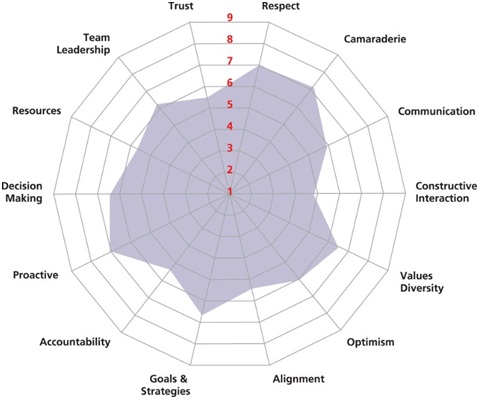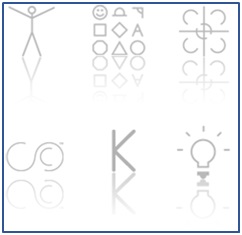An initial look at the results of any of the assessments displays the factors in a spider chart, as shown below3[3]. The survey participants consider how these results show up during the work of the team and are coached around how team strengths support the team and how weaker areas impact the team. The team is encouraged to identify which factor or factors are most important to focus on and develop an action plan to leverage and/or strengthen them.
 Although a coaching engagement could be limited to just revealing the results to either the team leader or the team, a more powerful engagement extends over several months to support continued action, new learnings, celebration and accountability. A follow-up assessment can be conducted to demonstrate progress and support ROI measurement.
Although a coaching engagement could be limited to just revealing the results to either the team leader or the team, a more powerful engagement extends over several months to support continued action, new learnings, celebration and accountability. A follow-up assessment can be conducted to demonstrate progress and support ROI measurement.
Five Dysfunctions of a Team
Because I don’t believe the use of the word ‘dysfunction’ is an inspiring perspective for a team, I’m going to accept the invitation the author extends in his book to look at the five dimensions from a more positive angle. The model itself is built around a ‘lack of’ these factors, but changing the perspective on them leads to the following five dimensions of the model.
 An effective team:
An effective team:
- Has trust in each other
- Engages in constructive conflict
- Demonstrates commitment to decisions, plans and actions
- Hold each other accountable
- Focuses on results
These success factors are highly interrelated and need to be addressed in the order presented. Each layer supports the next. When trust exists, conflict is not threatening. When conflict is encouraged, all voices can be heard, debated and discussed, leading to decisions that everyone can commit to. Even if they were initially opposed to the ideas behind the decision, their opinion was stated openly and heard, so unstated doubts will not surface later to sabotage the team’s efforts. Because the team has full commitment to decisions, they are willing to hold each other accountable for actions and behaviors that support the team’s goals. When actions and behaviors are aligned with the goals, results are achieved.
The model, depicted from its positive perspective, is seen with Trust as the foundational element.
A condensed version of the Five Dysfunctions team assessment is available in the Five Dysfunctions book and a more extensive online version is available for purchase through the company’s website. The assessment leads to a report that indicates where dysfunction might be present on a team and holding it back from creating the environment and results it desires or is in place to achieve. The coaching process centers around being aware of when the dysfunction (or its diametric strength) shows up on the team, what its impact is and what needs to be done about it. Individual team members can be singled out during this process when it is useful to either acknowledge or redirect certain attitudes, behaviors or actions.
Better Practice TM

The Better Practice approach is based on these ten guiding principles:
- simple good – other things being equal, the simplest option is usually the best
- the truth is enough – communicate clearly and directly
- ask for what you want – make your needs known
- manage what matters – identify and focus on what is important
- words matter – develop a common terminology all team members can refer to
- there can only be one source of truth – maintain team communications in one place
- capture the things that matter – if it’s important, document it
- manage with grace – how you do things matters
- beware the law of the unintended consequences – be prepared for the unexpected
- behold the power of the self-fulfilling prophecy – “If you think you can or think you can’t, you’re right.” (Henry Ford)
In keeping with these guiding principles, the Better Practice model considers six factors key to effective team performance, simple and without words. Given the unique aspect of each team, part of the process of them developing their own culture is to jointly decide what to call these dimensions – deciding for themselves which “words matter.”
Starting in the upper left and going clockwise, the pictograms represent:
- Individual – each team member provides contribution and has desires
- “Stuff” – goals, processes, resources must be in place
- Command/Control – solid leadership is critical
- Ideas – creativity leads to engagement and better products and services
- Kompetenz (German for Competence) – having the necessary skills available facilitates the work of the team
- Teamwork – it all comes together when trust, respect and camaraderie are present